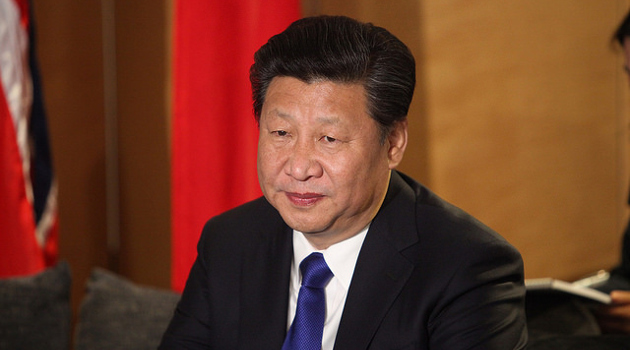Since trade promotes prosperity, I want increased market-driven, cross-border commerce between China and the United States.
But you can see in this CNBC interview that I’m worried about achieving that outcome given protectionism from President Trump and mercantilism from President Xi in China.
There’s never much chance to elaborate in short interviews, so here’s some additional analysis on the key points.
1. China’s economy is weak because of insufficient liberalization.
I have written about how China got great results – especially huge reductions in poverty – thanks to partial economic liberalization last century. But those reforms were just a step in the right direction. The country currently ranks only #107 according to Economic Freedom of the World, largely because so much of the economy is hampered by subsidies, regulation, protectionism, and cronyism. Sweeping pro-market reforms are needed if China’s leaders want their country to become rich.
2. Trump’s unthinking protectionism hurts both sides, but China may be more vulnerable.
I mentioned in the interview that Trump’s protectionism meant that he was harming both nations. This is what always happens with protectionism, so I wasn’t saying anything insightful. But it is quite likely that China will suffer more because its economy doesn’t have the flexibility and durability of America’s more market-oriented system.
That is one of the conclusion from a recent news report.
3. China’s cronyism presents a challenge for supporters of unilateral free trade.
I’m a supporter of unilateral free trade. America should eliminate all trade barriers, even if other nations want to hurt themselves by maintaining their restrictions. That being said, it’s not genuine free trade if another country has direct or indirect subsidies for its companies. As I noted in the interview, some economists say we shouldn’t worry since the net result is a wealth transfer from China’s taxpayers to America’s consumers. On the other hand, that approach means that some American workers and companies are being harmed. And if supporters of free markets are upset when American workers and companies are hurt by domestic cronyism, we also should be upset when the same thing happens because of foreign cronyism.
The challenge, of course, is whether you can use trade barriers to target only cronyism. I worry that such an effort would get hijacked by protectionists, though Professor Martin Feldstein makes a good argument in the Wall Street Journal that it’s the right approach.
China’s strategy is to give large government subsidies to state-owned companies and supplement their research with technology stolen from American and other Western companies. …That is the real reason why the Trump administration has threatened tariffs
of 25% on $200 billion of Chinese exports to the U.S.—nearly half the total—unless Beijing reforms its policies. …The purpose of the tariffs is not to reduce the bilateral trade deficit but to counter Chinese technology theft and forced transfer. …the U.S. could impose heavier tariffs and other economic penalties in order to force China to play by the rules, ending its attempt to dominate global markets through subsidies and technology theft.
4. Trump should have used the World Trade Organization to encourage Chinese liberalization.
I wrote last year that the President would enjoy more success if he used the WTO to apply pressure on China.
It’s not just me making this claim. Here are some excerpts from a story in the Washington Post.
Pressure from Europe and Japan is amplifying the president’s vocal complaints about Chinese trade practices… “it wasn’t a Trump issue; it was a world issue,” said Jorge Guajardo, …a former Mexican ambassador to China. “Everybody’s tired of the way China games the trading system and makes promises
that never amount to anything.” …Germany and the United Kingdom joined the United States this year in tightening limits on Chinese investment. …In September, trade ministers from the United States, European Union and Japan issued a joint statement that blasted the use of subsidies in turning “state owned enterprises into national champions and setting them loose in global markets.” The statement…also rejected forced technology transfer… The United States did win E.U. and Japanese support for a complaint to the WTO alleging China has violated U.S. intellectual property rights. But rather than use the global trade body for a broader attack on China, the administration has demanded changes in the way the organization operates. To critics, the administration missed an opportunity to marshal China’s trading partners behind an across-the-board indictment of its state-led economy.
5. The imperfect Trans-Pacific Partnership was an opportunity to pressure China to reduce cronyism.
Because of my concerns about regulatory harmonization, I wasn’t grievously disappointed when the United States chose not to participate in the TPP, but I fully recognized that the pact had very positive features. Including the pressure it would have placed on China to shift toward markets and away from cronyism.
6. Additional Chinese reform is the ideal outcome, both for China and the rest of the world.
Three years ago, I wrote that China needs a Reagan-style revolution of economic liberalization. That’s still true today. The bottom line is that China’s leaders should look at the progress that was achieved last century when the economy was partially liberalized and decide that the time is ripe for the free-market version of a great leap forward. In other words, the goal should be great economic success, not modest economic success.
I’ll conclude by pointing out that I don’t want China to copy the United States, even though that would be a step in the right direction.
According to data from Economic Freedom of the World, there’s a much better role model.
Indeed, I would like the United States to copy Hong Kong as well.
The recipe for prosperity is the same all over the world. The challenge is getting politicians to do what’s best for citizens rather than what’s best for themselves.
———
Image credit: Foreign and Commonwealth Office | CC BY 2.0.


